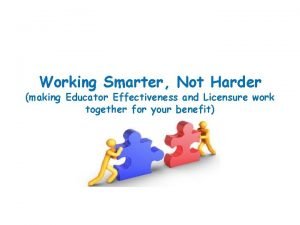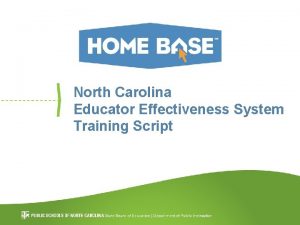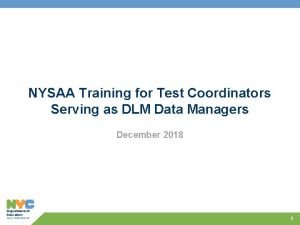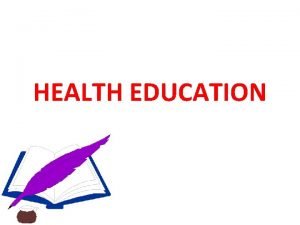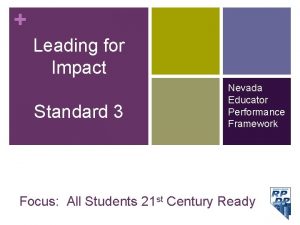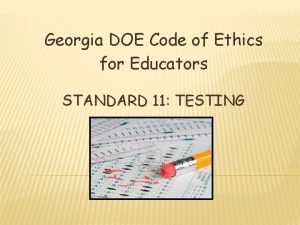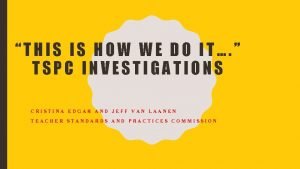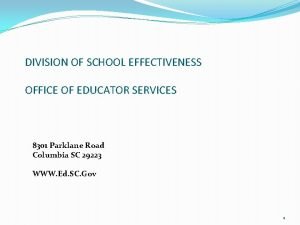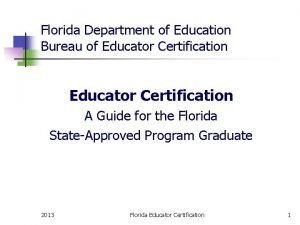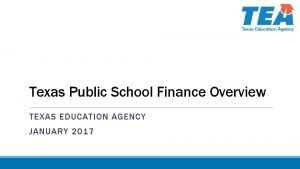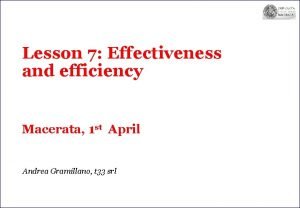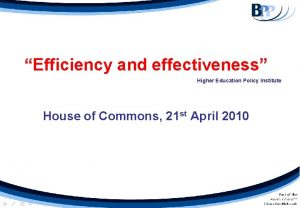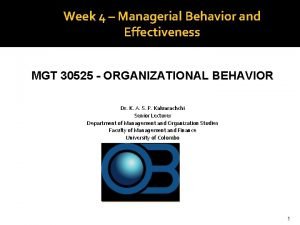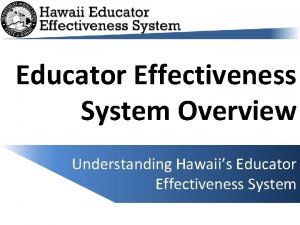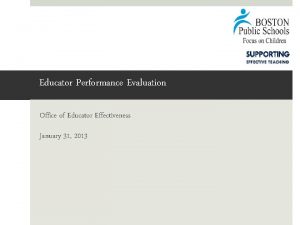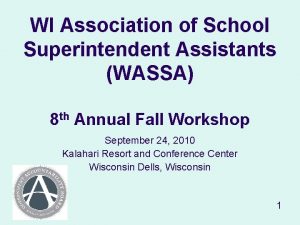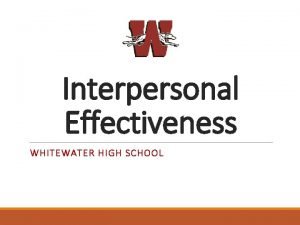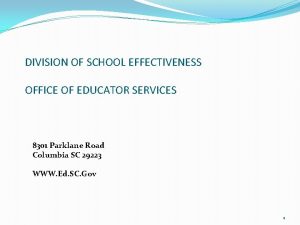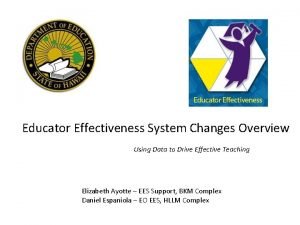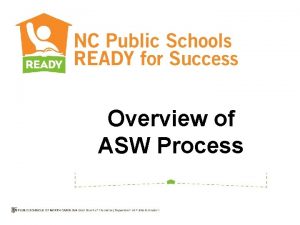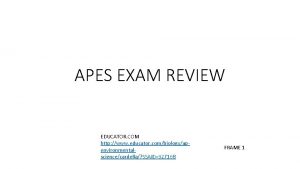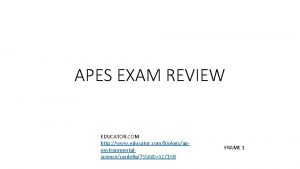An Overview of School and Educator Effectiveness WASSA

































- Slides: 33

An Overview of School and Educator Effectiveness WASSA Conference October 12, 2012 Michael J. Thompson, Ph. D Deputy State Superintendent Wisconsin Department of Public Instruction

Standards & Instruction – What and how should kids learn? Assessments and Data Systems – How do we know if they learned it? School and Educator Effectiveness – How do we ensure that students have highly effective teachers and schools? School Finance Reform – How should we pay for schools? 2

Standards and Instruction What and how should kids learn? Implement internationally benchmarked academic standards • Expand systems that promote early interventions in reading and mathematics. • Use digital learning to change and enhance instruction; and • Expand high school programs for dual enrollment earning college credit and specific career skills. • 3

Assessments and Data Systems How do we know if they learned it? • Change state assessment proficiency levels, to reflect the National Assessment of Educational Progress (NAEP); • Implement an online, adaptive next generation assessment system. • Launch statewide student information and data systems that support districts, streamline operations, and provide accurate and useable information. 4

School and Educator Effectiveness How do we ensure kids have highly effective teachers and schools? • Replace broken No Child Left Behind requirements with a new state accountability and support system; • Replicate best practices from high-performing schools and provide support to improve the lowest-performing schools; • Advance a fair and robust educator evaluation system. 5

School Finance Reform How should we pay for schools? • Guarantee a minimum amount of state aid for every student; • Incorporate a poverty factor into the formula, accounting for families’ ability to pay—not just property value; • Establish sustainability in state funding, while strengthening rural, declining enrollment, and negatively aided districts; and • Redirect the school levy tax credit directly into school aids. 6

New accountability system begins & AYP ends (ESEA waiver) New proficiency benchmarks for WKCE reading & mathematics established SMARTER Balanced assessment field testing Educator Effectiveness system design continues; Act 166 passed 2011 -12 ASSETS for ELL assessment in use Educator Effectiveness statewide system pilot 2012 -13 New school report cards first issued (2011 -12 accountability reports) New kindergarten literacy screener administered statewide DPI provides curricular resources for Common Core State Standards implementation First districts using State Student Information System (SSIS) Developmental pilot of Educator Effectiveness system 2013 -14 All districts on SSIS 2014 -15 Common Core State Standards fully incorporated into school/district curricula 2015 -16 2016 -17 Higher graduation requirements (targeted –needs legislation) Smarter Balanced replaces WKCE & WAASw. D in mathematics and English/Language Arts, including reading and writing Educator Effectiveness system implemented statewide 7

2011 -12 2012 -13 2013 -14 2014 -15 2015 -16 2016 -17 New school report cards first issued (2011 -12 accountability reports) New kindergarten literacy screener administered statewide DPI provides curricular resources for Common Core State Standards implementation First districts using State Student Information System (SSIS) Developmental pilot of Educator Effectiveness system 8

Wisconsin’s School Report Cards October 2012

Agenda 2017 Standards & Instruction – What and how should kids learn? Assessments and Data Systems – How do we know if they learned it? School and Educator Effectiveness – How do we ensure that students have highly effective teachers and schools? School Finance Reform – How should we pay for schools?

Data. Informed Decisions Support for Individualized Learning High Academic Standards Constructive Accountability College & Career Ready Balanced Assessment Support for School Improvement Effective Educators

Accountability Index § A comprehensive accountability index has replaced the AYP pass-fail system. AYP reports are gone; accountability reporting will now be done with School Report Cards (2011 -12). § The index is a composite of sub-scales that measure performance across four priority areas : v Student Achievement v Student Growth v Closing Gaps v On-track to Graduation/Postsecondary Readiness § Student Engagement indicators, if missed, result in 5 point deduction v Test Participation Rate v Absenteeism Rate v Dropout Rate § The index score is on a 0– 100 scale. Sub-scale scores as well as the index score will be reported to enhance transparency and differentiation.

Accountability Ratings § The index score will place schools into one of five rating levels: 1. 2. 3. 4. 5. Significantly Exceeds Expectations Meets Few Expectations Fails to Meet Expectations § These ratings serve as the new accountability determinations and determine level of support. 13

School Report Cards § School Report Cards provide each school’s overall score, priority area scores, and student engagement indicator performance. They also include WSAS performance over the last five years. § School Report Card Detail packets provide more information related to the accountability calculations as well as additional data to inform local conversations and school improvement efforts. § An Interpretive Guide is meant to provide information about the Report Cards. § A Technical Guide will help users interested in the specific details of index calculations.

State and Federal Accountability § The report cards: ØReplace AYP reports ØServe as the primary reporting tool for the state accountability system ØWill be issued annually ØAre in addition to Title I identifications (Priority and Focus), which are federally required cohorts (every four years) 15

Summary Points • The report cards reflect a better, more comprehensive way of measuring schools’ effectiveness in helping students graduate ready for college and career. • The accountability index is based on multiple factors: student achievement on WSAS and the ACT, growth in student achievement, progress in closing achievement gaps, student progress toward postsecondary readiness, graduation rates, and attendance. • The report cards provide valuable guidance on how our schools are doing and where to improve. In combination with other school data, they can help schools plan and evaluate their improvement efforts. • The DPI will explore including more measures of college- and career-readiness in the index calculations in the future. 16

Release Schedule – Preliminary Report Cards • Secure Release – week of September 24 – PDFs in SAFE (educators only) – Preliminary and secure (embargoed) • Updated Secure Release – week of October 8 – PDFs in SAFE (educators only) – Preliminary and secure (embargoed) • Preliminary Public Release – week of October 22 – PDFs posted to DPI webpage organized by district – Preliminary but public (with redaction) – Searchable state file with determinations 17

Timeline New accountability system begins & AYP ends (ESEA waiver) New WKCE benchmarks established for reading, math Title I Priority & Focus schools identified Smarter Balanced assessment field testing Educator Effectiveness system design continues; Act 166 passed Educator Effectiveness statewide pilot 2011 -12 2012 -13 New school report cards first issued (2011 -12 accountability reports) New system of support for Title I Priority & Focus schools begins New kindergarten literacy screener administered statewide DPI provides curricular resources for Common Core State Standards implementation First districts begin pilot of Educator Effectiveness system 2013 -14 ASSETS for ELLs assessment in use 2014 -15 Common Core State Standards fully incorporated into school/district curricula Smarter Balanced & Dynamic Learning Maps replace WKCE & WAA-Sw. D in math, English Language Arts (incl. reading & writing) Educator Effectiveness system implemented 2015 -16 2016 -17 First graduating class with higher graduation requirements (targeted – needs legislation)

For more information, please visit: http: //www. dpi. wi. gov/oea/acct/accountability. html Email eseawaiver@dpi. wi. gov 19

Context of the Educator Effectiveness Work • State Superintendent’s Educator Effectiveness Design Team – Diverse Membership, National and State Support and Expertise • State legislation (Act 166) – Endorses broad parameters of EE Framework – Districts must implement evaluation systems consistent with legislation by 2014 -2015 • Federal push: (July 2012) ESEA Waiver approval 20

Formation and Charge of a Design Team • Design Team formed in December 2010 • Charged to develop: – definitions of key guiding principles of a highquality educator effectiveness program, – model performance-based evaluation systems for teachers and principals, – a regulatory framework for implementation that includes how student achievement data will be used in context, and – recommendations for methods to support improvement and incentives for performance. 21

Guiding Principles of the System An educator evaluation system must deliver information that: – Guides effective educational practice that is aligned with student learning and development – Documents evidence of effective educator practice – Documents evidence of student learning – Informs appropriate professional development – Informs educator preparation programs – Supports a full range of human resource decisions – Is credible, valid, reliable, comparable, and uniform across districts 22

A System of Seamless Transitions Pre-service Evaluation Licensing License Renewal & the PDP Process 23

Effective Educators • An effective teacher consistently uses educational practices that foster the intellectual, social and emotional growth of children, resulting in measurable growth that can be documented in meaningful ways. • An effective principal shapes school strategy and educational practices that foster the intellectual, social and emotional growth of children, resulting in measurable growth that can be documented in meaningful ways. 24

System Weights Sales Educator Practice 50% Student Growth 50% 25

Standards for Educator Practice Teacher Practice In. TASC Teaching Standards (2011) Framework for Teacher Evaluation Charlotte Danielson’s Domains & Components Domain 1: Planning and Preparation Domain 2: The Classroom Environment Domain 3: Instruction Domain 4: Professional Responsibilities Principal Practice 2008 Interstate School Leaders Licensure Consortium (ISLLC) Standards Framework for Principal Evaluation Subordinate functions of the ISLLC standards 26

Educator Effectiveness Measures Percent Practice measures State Assessment (value-added model) 15% District Assessment 15% 50% 15% Student Learning Objectives 2. 5% School-wide Reading (Elementary-Middle) District Graduation (High School) Choice 27

Multiple Performance Categories Developing: does not meet expectations and requires additional support and directed action Effective: areas of strength and improvement addressed through professional development Exemplary: expand expertise through professional development and use expertise in leadership The initial recommendation of the Design Team included three performance categories. The Coordinating Committee met on July 26, 2012, and determined that five rating categories would be part of the Developmental Pilot as opposed to three. 28

Educator Effectiveness System Matrix Student Outcomes Models of Practice 1 2 1 3 4 5 * * 2 * 3 4 * 5 * * • Asterisks indicate a mismatch between educator’s practice performance and student outcomes and requires a focused review to determine why the mismatch is occurring and what, if anything, needs to be corrected. 29

Educator Effectiveness Timeline Stage 1 Developing December 2010 - June 2012 Framework released Model development Stage 2 Piloting July 2012 - June 2013 Developmental Pilots Continued Development Evaluator and Educator training Stage 3 Implementing July 2013 - June 2014 Pilot Evaluation Model revisions Pilot expansion to prepare for statewide implementation 30 July 2014 -June 2015 Educator Effectiveness system fully implemented statewide

Teaching is complex… The Wisconsin Educator Effectiveness System acknowledges this: • Intentional, thoughtful in its design. • Credible, valid, reliable, comparable, and uniform across districts.

Staying Informed and Involved Visit the DPI Website: http: //www. dpi. wi. gov/tepdl/edueff. html The Framework, presentations, FAQs, and draft process manuals can be found posted on the website 32

Staying Informed and Involved DPI Organization 33
 Slo and ppg examples
Slo and ppg examples Nc educator effectiveness system
Nc educator effectiveness system Allied educator moe
Allied educator moe Kite nysaa
Kite nysaa Duration of micro lesson plan is
Duration of micro lesson plan is Remunerative conduct
Remunerative conduct Georgia educator code of ethics
Georgia educator code of ethics Msde educator portal
Msde educator portal Nurse educator resume
Nurse educator resume Microsoft teacher academy
Microsoft teacher academy Definition of health education
Definition of health education Harvard business publishing education
Harvard business publishing education Alabama educator code of ethics
Alabama educator code of ethics Turing tumble simulator
Turing tumble simulator Nevada educator performance framework
Nevada educator performance framework Georgia educator code of ethics
Georgia educator code of ethics Tspc sanction list
Tspc sanction list Vumc educator portfolio
Vumc educator portfolio Office of educator services
Office of educator services Cg-10 application form
Cg-10 application form Ct teacher certification reciprocity
Ct teacher certification reciprocity Microsoft educator network
Microsoft educator network Texas public school finance overview
Texas public school finance overview British school system
British school system British school system overview
British school system overview Texas public school finance overview
Texas public school finance overview The effectiveness of online and blended learning
The effectiveness of online and blended learning It is an arrangement of people in organization
It is an arrangement of people in organization Efficiency and effectiveness examples
Efficiency and effectiveness examples Efficiency and effectiveness examples
Efficiency and effectiveness examples Efficiency and effectiveness in higher education
Efficiency and effectiveness in higher education Managing productivity and marketing effectiveness
Managing productivity and marketing effectiveness Managerial behavior and effectiveness
Managerial behavior and effectiveness Wjec criminology unit 4 revision
Wjec criminology unit 4 revision
